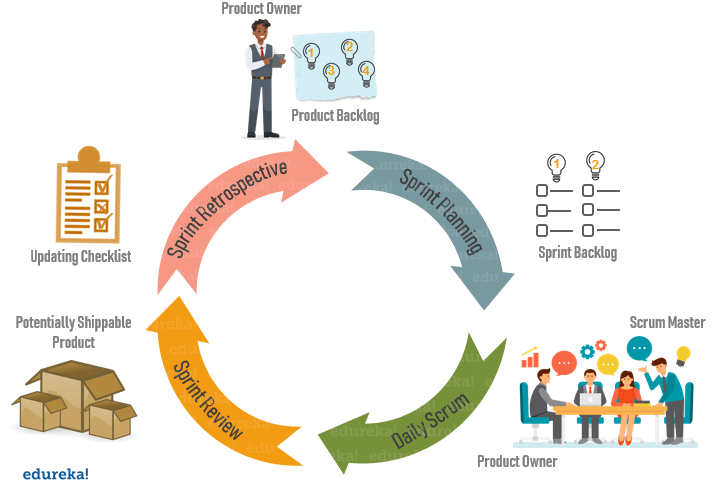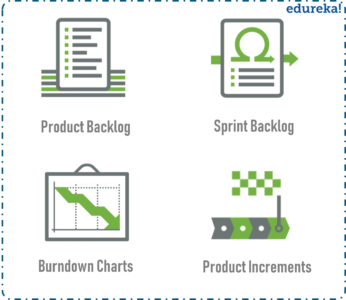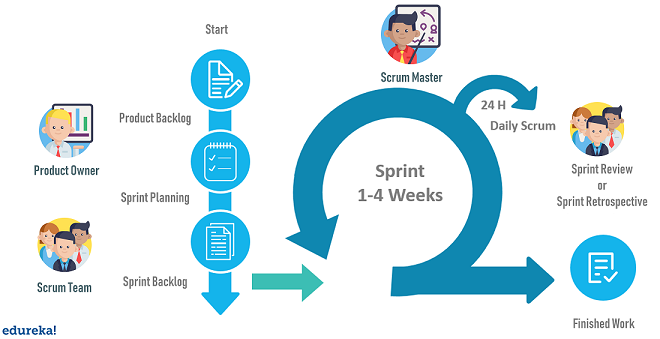PMP Certification Training
- 86k Enrolled Learners
- Weekend/Weekday
- Live Class
Building a new product or a feature isn’t really an easy task, and having it succeed in a competitive marketplace is even more of a challenge. Agile Scrum Methodology helps achieve that.
Good products captivate a target audience by addressing customer needs. The person that achieves this for his/her company is a Certified Scrum Master and he/she is rewarded quite handsomely for the same.
The Scrum Guide defines scrum as:
“A framework within which people can address complex adaptive problems, while productively and creatively delivering products of the highest possible value.”
In simple terms, scrum is a lightweight agile project management framework that can be used to manage iterative and incremental projects of all types. The concept here is to break large complex projects into smaller stages, reviewing and adapting along the way. With scrum you:
So, scrum is a flexible way of working on any kind of projects in this rapidly changing world. But that still leaves a lot of questions about the Scrum Framework. If you want to ask questions from experts, you can definitely check out CSM Training by Edureka. The first step is to drill down a bit further into Scrum’s origins and history.
The term “scrum” was first introduced by two professors Hirotaka Takeuchi and Ikujiro Nonaka in the year 1986, in Harvard Business Review article. There they described it as a “rugby” style approach to product development, one where a team moves forward while passing a ball back and forth.
Software developers Ken Schwaber and Jeff Sutherland each came up with their own version of Scrum, which they presented at a conference in Austin, Texan in 1995. In the year 2010, the first publication of official scrum guide came out.
Let’s get to the next part of this “What is Scrum?” article and learn about the people and parts involved with Scrum Framework.
The Scrum Framework is made of three distinct categories, which are:
Let’s check out each of these.
There are three distinct roles defined in Scrum:

Now that you have an idea of what scrum is and the people involved, its time to learn about different events that occur during the scrum process.
In particular, there are four events that you will encounter during the scrum process. But before we proceed any further you should be aware of what sprint is.
A sprint basically is a specified time period during which a scrum team produces a product.
The four events or ceremonies of Scrum Framework are:

To understand scrum properly, you need to be aware of the artifacts that are used during the scrum process. So, let’s discuss them.
Artifacts are just physical records that provide project details when developing a product. Scrum Artifacts include:

Well, this covers all the terms that you might come across when working with Scrum Framework. But, how does the scrum actually work?

Step1: Scrum process begins with a product owner. Product Owner creates a product backlog, a list of tasks and requirements the final product needs. The important part is that product backlog must be prioritized.
Step2: The scrum team gets together for sprint planning, which is when the team decides together what to work on first from the product backlog. This subset of items from the product backlog becomes the sprint backlog.
Step3: During the sprint, the team meets to communicate progress and issues, this meeting is called the daily scrum. It is overseen by the scrum master who ensures that all the team members follow scrum’s theories, rules, and practices.
Step4: At the end of the sprint, the sprint review meeting is organized by the product owner. During the meeting, the development team demonstrates what they completed since the last sprint. Then the product owner gives information about what is remaining on the product backlog and estimated time to complete the project if needed.
Note: In scrum, at the end of each sprint, the team should have a functioning piece of the product to show for their work.
Step5: After the sprint review, the scrum team gathers-up in sprint retrospective meeting, where the team discusses what went well, what did not and if they could have done better. Might be a tech limitation is holding them back or a team member is overloaded with tasks. The team decides how to fix these problems and creates a plan for improvements to be enacted during the next sprint.
Step6: The cycle repeats for the remaining tasks in the product backlog. This goes on until either of the below-mentioned things happen:
And that, in a nutshell, is how Scrum works. An important principle in scrum is the idea of transparency. All team members involved should be aware of what everyone else is working on, progress being made, and what the team is trying to accomplish.
This brings us to the end of this ‘What is Scrum?’ article. I have covered all the basics that you should be aware of if you are planning to use scrum methodology. Hope you are clear with all that has been shared with you in this article.
If you want to build a community of folks around you & master scrum from experts, you can check out the CSM Training in Chennai.
Make sure you are well versed with the Scrum terminology before you start using it.
Got a question for us? Please mention it in the comments section of this “What is Scrum?” article and we will get back to you as soon as possible. Alternatively, check out Scrum master Course by Edureka and master it from experts.
 Thank you for registering Join Edureka Meetup community for 100+ Free Webinars each month JOIN MEETUP GROUP
Thank you for registering Join Edureka Meetup community for 100+ Free Webinars each month JOIN MEETUP GROUPedureka.co